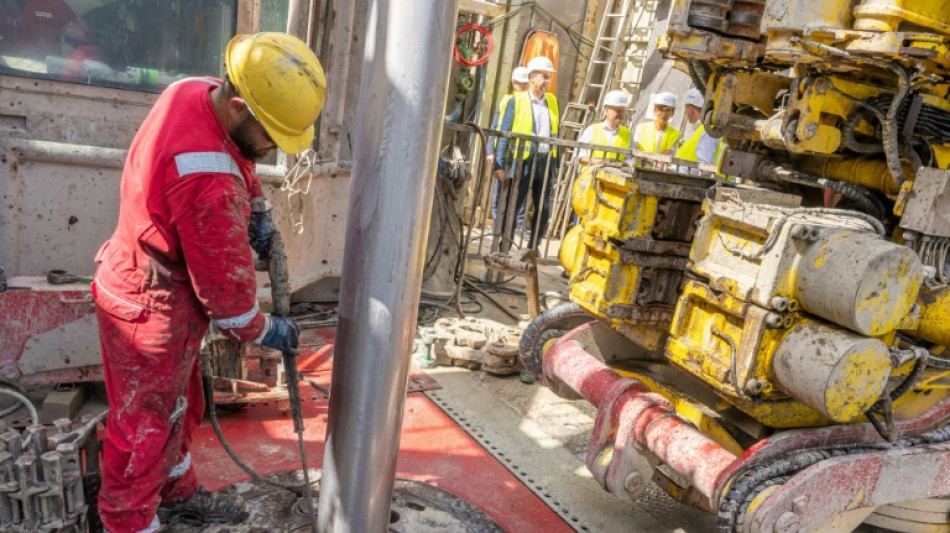
-
 'Killed without knowing why': Sudanese exiles relive Darfur's past
'Killed without knowing why': Sudanese exiles relive Darfur's past
-
Stocks lower on uncertainty over tech rally, US rates

-
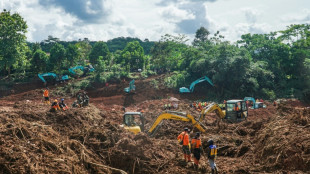 Death toll from Indonesia landslides rises to 18
Death toll from Indonesia landslides rises to 18
-
Macron, Zelensky sign accord for Ukraine to buy French fighter jets

-
 India Delhi car bomb accused appears in court
India Delhi car bomb accused appears in court
-
Bangladesh ex-PM sentenced to be hanged for crimes against humanity
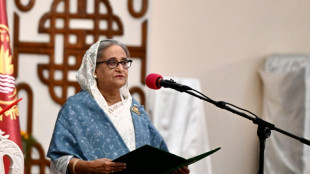
-
 Leftist, far-right candidates advance to Chilean presidential run-off
Leftist, far-right candidates advance to Chilean presidential run-off
-
Bangladesh's Hasina: from PM to crimes against humanity convict
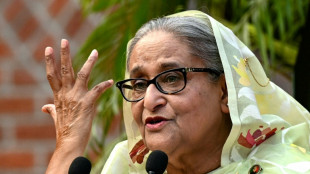
-
 Rugby chiefs unveil 'watershed' Nations Championship
Rugby chiefs unveil 'watershed' Nations Championship
-
EU predicts less eurozone 2026 growth due to trade tensions

-
 Swiss growth suffered from US tariffs in Q3: data
Swiss growth suffered from US tariffs in Q3: data
-
Bangladesh ex-PM sentenced to death for crimes against humanity
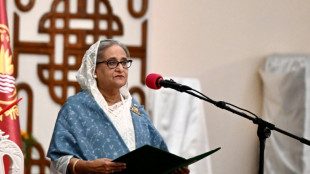
-
 Singapore jails 'attention seeking' Australian over Ariana Grande incident
Singapore jails 'attention seeking' Australian over Ariana Grande incident
-
Tom Cruise receives honorary Oscar for illustrious career

-
 Fury in China over Japan PM's Taiwan comments
Fury in China over Japan PM's Taiwan comments
-
Carbon capture promoters turn up in numbers at COP30: NGO

-
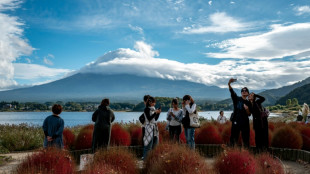 Japan-China spat over Taiwan comments sinks tourism stocks
Japan-China spat over Taiwan comments sinks tourism stocks
-
No Wemby, no Castle, no problem as NBA Spurs rip Kings

-
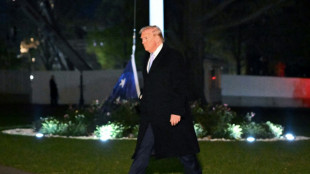 In reversal, Trump supports House vote to release Epstein files
In reversal, Trump supports House vote to release Epstein files
-
Gauff-led holders USA to face Spain, Argentina at United Cup

-
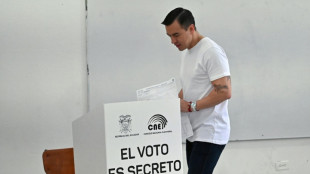 Ecuador voters reject return of US military bases
Ecuador voters reject return of US military bases
-
Bodyline and Bradman to Botham and Stokes: five great Ashes series

-
 Iran girls kick down social barriers with karate
Iran girls kick down social barriers with karate
-
Asian markets struggle as fears build over tech rally, US rates

-
 Australia's 'Dad's Army' ready to show experience counts in Ashes
Australia's 'Dad's Army' ready to show experience counts in Ashes
-
UN Security Council set to vote on international force for Gaza
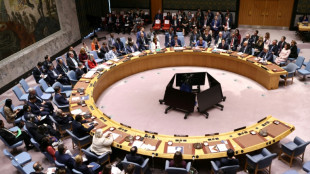
-
 Japan-China spat sinks tourism stocks
Japan-China spat sinks tourism stocks
-
Ecuador voters set to reject return of US military bases
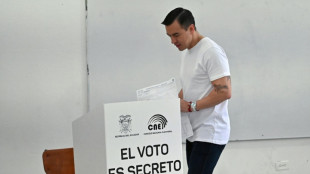
-
 Trump signals possible US talks with Venezuela's Maduro
Trump signals possible US talks with Venezuela's Maduro
-
Australian Paralympics gold medallist Greco dies aged 28

-
 Leftist, far-right candidates go through to Chilean presidential run-off
Leftist, far-right candidates go through to Chilean presidential run-off
-
Zelensky in Paris to seek air defence help for Ukraine

-
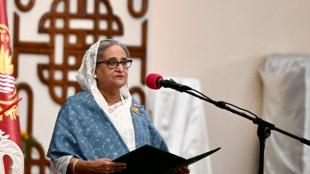 Bangladesh verdict due in ex-PM's crimes against humanity trial
Bangladesh verdict due in ex-PM's crimes against humanity trial
-
A pragmatic communist and a far-right leader: Chile's presidential finalists
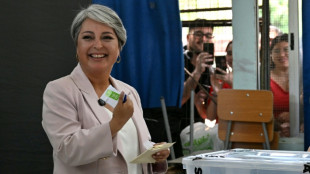
-
 England ready for World Cup after perfect campaign
England ready for World Cup after perfect campaign
-
Cervical cancer vaccine push has saved 1.4 million lives: Gavi
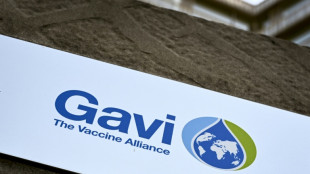
-
 World champion Liu wins Skate America women's crown
World champion Liu wins Skate America women's crown
-
Leftist leads Chile presidential poll, faces run-off against far right

-
 Haaland's Norway thump sorry Italy to reach first World Cup since 1998
Haaland's Norway thump sorry Italy to reach first World Cup since 1998
-
Portugal, Norway book spots at 2026 World Cup

-
 Sinner hails 'amazing' ATP Finals triumph over Alcaraz
Sinner hails 'amazing' ATP Finals triumph over Alcaraz
-
UK govt defends plan to limit refugee status

-
 Haaland's Norway thump Italy to qualify for first World Cup since 1998
Haaland's Norway thump Italy to qualify for first World Cup since 1998
-
Sweden's Grant captures LPGA Annika title

-
 Tuchel lays down law to Bellingham after England star's frustration
Tuchel lays down law to Bellingham after England star's frustration
-
Sinner caps eventful year with ATP Finals triumph over great rival Alcaraz

-
 Portugal book spot at 2026 World Cup as England stay perfect
Portugal book spot at 2026 World Cup as England stay perfect
-
Hakimi, Osimhen, Salah shortlisted for top African award

-
 Sinner beats great rival Alcaraz to retain ATP Finals title
Sinner beats great rival Alcaraz to retain ATP Finals title
-
Schenk wins windy Bermuda Championship for first PGA title


Dig deep: US bets on geothermal to become renewable powerhouse
Though geothermal represents only a tiny fraction of current US energy production, several businesses and President Joe Biden's administration are betting on technological advances to make it a backbone of the green transition.
"If we can capture that heat beneath our feet, it can be the clean, reliable, baseload-scalable power for everybody from industries to households," Energy Secretary Jennifer Granholm told the CERAWeek conference in Houston this past week.
Her department estimates that geothermal energy could overtake hydroelectric and solar power in the country by 2050.
Geothermal, which draws on naturally high temperatures underground and is used mainly to produce electricity and heat buildings, amounted to only 1.6 percent of US energy consumption in 2022.
To ramp up production, the US government has invested more than $200 million since 2018 in an experimental site in Utah involving the drilling of exceptionally deep wells -- an approach different from the traditional, near-surface geothermal energy.
Scientists at the site have been testing, in real-world conditions, a technology known as Enhanced Geothermal Systems (EGS), similar but different from hydraulic fracturing techniques, also known as fracking, which is used to extract oil and natural gas.
The approach involves injecting water into naturally very hot rocks -- often deeper than two miles (3 kilometers), which does not require a nearby hot spring or underground reservoir.
"In theory, you could make geothermal anywhere," said Francesco d'Avack, an analyst with S&P Global Commodity Insights.
"It also reduces the upfront risk," he said -- that is, the risk of drilling and finding nothing, which has been a deterrent for some investors in the past.
Granholm, in her speech to the CERAWeek energy conference, underscored another advantage: the US government is allowing companies to convert permits for oil or gas exploration into geothermal licenses -- reducing paperwork and delays.
In a report this past week, the Energy Department said EGS use fewer chemical additives than classic fracking, a system deplored by environmentalists.
It added that geothermal drilling does not release hydrocarbons, as fracking does.
And unlike solar or wind power, geothermal provides a steady flow of energy regardless of weather or time of day.
- 'A big unlock' -
As for cost, the US government estimates it will drop from a current range of $70 to $100 per megawatt hour (MWh) to $45 by 2035.
The use of existing drilling technology makes geothermal both quicker and cheaper to develop.
"We took the oil and gas operation models, we changed the drill bits a little bit and... we demonstrated a completely new application," said Jigar Shah of the Energy Department's loan office. "That's a big unlock" -- a big leap forward.
"The US has been a first mover" with the new technology, said Ajit Menon, a specialist in subterranean development with Texas-based energy company Baker Hughes, which has invested in geothermal energy.
There are already EGS sites in other countries, notably France, but they're considered experimental.
A possible risk of geothermal drilling projects is that, as with fracking, they can cause seismic activity.
In France's Alsace region, a deep-drilling project was abandoned in 2020 after it provoked several tremors.
The US Energy Department requires all funded projects follow a mitigation protocol to address induced seismicity and is funding research on the issue.
It says no community has felt seismicity occurring near a DOE-funded project.
Several US and Canadian start-ups are vying for position in this budding market and have raised hundreds of millions of dollars from investors.
One of them, Fervo Energy, recently linked its Nevada site to the electric grid. The project was developed in collaboration with Google, which needs huge amounts of electricity for its data centers. So far, though, the site is generating only 3.5 megawatts.
As the geothermal supply begins to grow, demand is following. Google, Microsoft and steel-maker Nucor announced Tuesday that they will jointly be purchasing geothermal energy.
Shah pointed out that the three big firms are "willing to pay a premium" for the energy, and that "gets the private sector excited."
"The new or next generation market is still quite open," said Cindy Taff, CEO of Sage Geosystems, which specializes in subterranean energy. One reason, she said, is that "we need that first commercial facility, and there hasn't been one" yet.
Once one company shows how it can be successfully done, others will follow, she added.
With the sector still so small, "your primary objective is to grow it right," said Menon. "Not only for you -- for everyone."
P.AbuBaker--SF-PST




